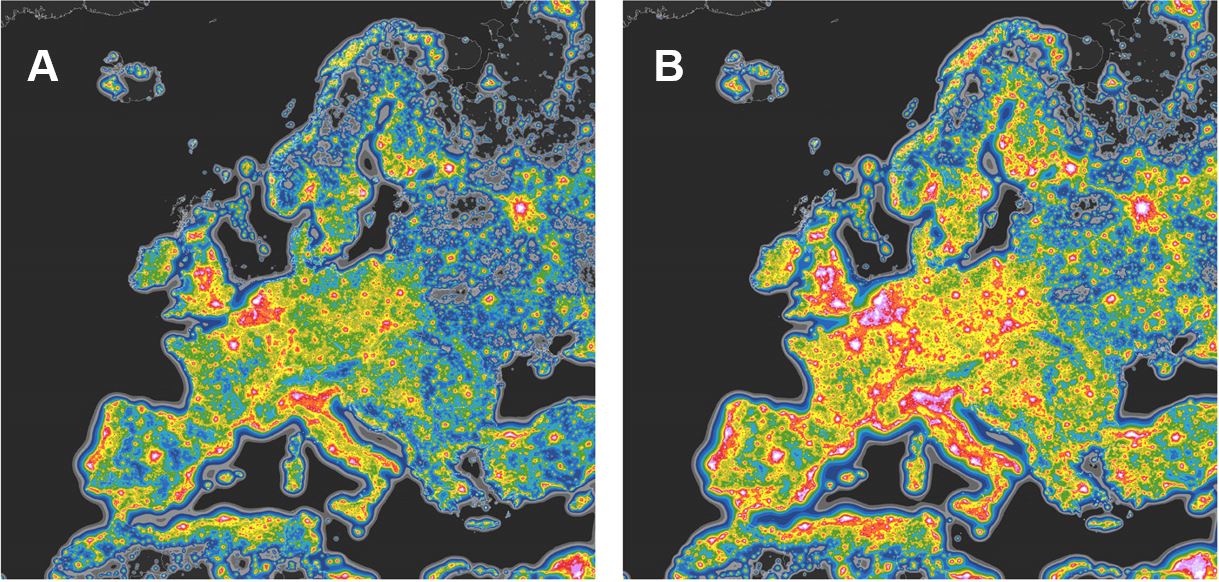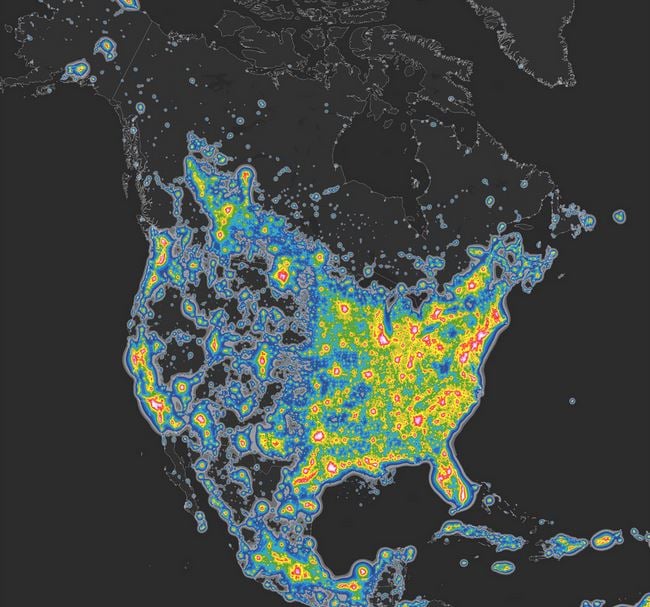One third of us globally cannot see the Milky Way in the night sky because of light pollution – artificial light that brightens the night sky – says an international team of scientists who created the ‘New World Atlas of Artificial Night Sky Brightness’.
The scientists, from Israel, Germany, Italy and the USA, published the new atlas in the open-access journal Science Advances (citation below). It documents the degree to which different parts of the world are illuminated by artificial skyglow.
Artificial skyglow is the diffuse luminance of the night sky originating from light we produce, as opposed to the natural night light from the Moon and other celestial bodies.
 Polar graph showing the 3 different light intensity distributions used to compute the three map versions: the Lambertian distribution with a peak toward the zenith (blue), the function with peak intensity at low angles above the horizon plane (green), and the function with peak at intermediate angles, 30° above the horizon plane (yellow). The red line shows the overall best-fitting function. (Image: Science Advances)
Polar graph showing the 3 different light intensity distributions used to compute the three map versions: the Lambertian distribution with a peak toward the zenith (blue), the function with peak intensity at low angles above the horizon plane (green), and the function with peak at intermediate angles, 30° above the horizon plane (yellow). The red line shows the overall best-fitting function. (Image: Science Advances)
Pollution refers to anything in the environment that should not be there and may cause harm. Light pollution, for example, can cause insomnia, headaches, anxiety, and other health problems.
Light pollution also affects wildlife
Study leader, Fabio Falchi from the Italian Light Pollution Science and Technology Institute (ISTIL), and colleagues explained that light pollution is not only a nuisance for astronomers and amateur skygazers, it also affects nocturnal organisms and our ecosystems.
Falchi explained:
“The new atlas provides a critical documentation of the state of the night environment as we stand on the cusp of a worldwide transition to LED technology.”
“Unless careful consideration is given to LED color and lighting levels, this transition could unfortunately lead to a 2-3 fold increase in skyglow on clear nights.”
 The map above shows the artificial sky brightness as a ratio to the natural sky brightness (assumed to be 174 μcd/m2). (Image: Science Advances)
The map above shows the artificial sky brightness as a ratio to the natural sky brightness (assumed to be 174 μcd/m2). (Image: Science Advances)
Our skies have changed significantly
The atlas maps a world which has changed considerably over the past 200 years – today much of it is awash with light. In Western Europe, for example, there are just a handful of small areas left where the night sky is relatively unaffected by light pollution, including regions in Austria, Spain, Scotland, Sweden and Norway.
Apart from the world map, the researchers also provide tables showing the areas of each nation and what proportion of its population lives under skies with high concentrations of skyglow.
The scientists specifically gathered and analysed data from the G20 nations – the twenty largest economies in the world – and found that in terms of area, the most light-polluted are South Korea and Italy, while Australia and Canada have the lowest concentrations of artificial skyglow.
Citizens of Germany and India are most likely to be able to see our galaxy (Milky Way) from their home, while those in South Korea and Saudi Arabia are least likely.
Thanks to a new satellite and the recent development of cheap sky radiance meters, major advances over the 2001 atlas were possible.
 Maps of Europe’s artificial sky brightness, in twofold increasing steps. Map ‘A’ shows artificial night brightness in V-band, map ‘B’ shows the forecast in the perceived sky brightness for a dark-adapted eye after a transmission toward 4000K CCT LED technology, without increasing the photopic flux of lamps that are currently installed. (Image: Science Advances)
Maps of Europe’s artificial sky brightness, in twofold increasing steps. Map ‘A’ shows artificial night brightness in V-band, map ‘B’ shows the forecast in the perceived sky brightness for a dark-adapted eye after a transmission toward 4000K CCT LED technology, without increasing the photopic flux of lamps that are currently installed. (Image: Science Advances)
Citizen scientists vital for whole project
The researchers calibrated the atlas using Sky Quality Meters at 20,865 different locations across the globe. They were especially grateful for the participation of citizen scientists in gathering calibration data, which they described as ‘critical’.
Co author Dr. Christopher Kyba, who works at GFZ German Research Centre for Geosciences as a researcher, said:
“Citizen scientists provided about 20% of the total data used for the calibration, and without them we would not have had calibration data from countries outside of Europe and North America.”
 Night brightness in North America and the Caribbean. (Image: Science Advances)
Night brightness in North America and the Caribbean. (Image: Science Advances)
Dr. Sibylle Schroer, who coordinates the EU funded ‘Loss of the Night Network’ and was not a study author, said: “The community of scientists who study the night have eagerly anticipated the release of this new Atlas.”
Scott Feierabend, Director of the International Dark-Sky Association, said:
“The new atlas acts as a benchmark, which will help to evaluate the success or failure of actions to reduce light pollution in urban and natural areas.”
In an Abstract that precedes the main paper in the journal, the researchers wrote:
“This atlas shows that more than 80% of the world and more than 99% of the U.S. and European populations live under light-polluted skies.”
“The Milky Way is hidden from more than one-third of humanity, including 60% of Europeans and nearly 80% of North Americans. Moreover, 23% of the world’s land surfaces between 75°N and 60°S, 88% of Europe, and almost half of the United States experience light-polluted nights.”
Citation
“The new world atlas of artificial night sky brightness,” Fabio Falchi, Pierantonio Cinzano, Dan Duriscoe, Christopher C. M. Kyba, Christopher D. Elvidge, Kimberly Baugh, Boris A. Portnov, Nataliya A. Rybnikova and Riccardo Furgoni. Science Advances, Vol. 2, no. 6, e1600377. 10 June 2016. DOI: 10.1126/sciadv.160037.
Video – Light pollution in our night skies
In this Science News video (no sound) you can see an image of the Earth rotating with different colours on its surface representiing various intensities of artificial light.
